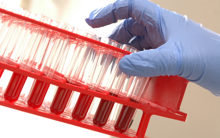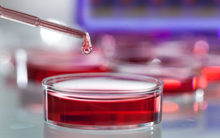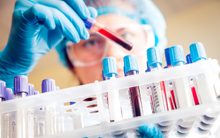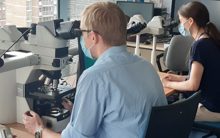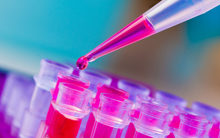Part of the College’s mission is to promote study, research and innovation within the field of pathology. Our annual College Research Medals recognise outstanding research work undertaken by pathologists or scientists in training.
We previously published an interview with our September 2024 Silver Research Medal winner, Dr Joe Westaby. This week, we’re turning the spotlight to the September 2024 Gold Research Medal winner, Dr Mohsin Badat.
Dr Badat’s research centres around a novel approach to cure HbE/beta-thalassaemia using base editing. We asked him to talk us through his research, how he balances the clinical and research aspects of his work, and his advice for early career researchers interested in pathology.
I knew I liked haematology back then, probably because the link between genetics, molecular mechanisms and patients' symptoms was so clear, especially in the haemoglobinopathies... Haematology is also its own little world that you can do so many things within; you can study blood disorders in a research lab, take care of the investigation of samples in a clinical lab or have a very clinical patient-orientated job.
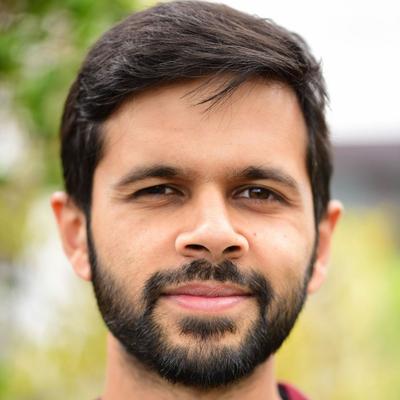
Can you tell us a bit about your background? What drew you to pathology, and haematology in particular?
I'm a paediatric haematologist. I've just been appointed to a Senior Clinical Lecturer post at the Blizard Institute at Queen Mary University of London, and an Honorary Paediatric Haematology Consultant position at the Royal London Hospital in Whitechapel. I graduated from the University of Cambridge and did my foundation jobs near there before relocating to London, as I wanted to work with patients with red blood cell disorders. I did my paediatric and subsequent haematology training in the North-East London rotation, finishing in August 2024. In between all of that I completed a PhD at the Weatherall Institute of Molecular Medicine in Oxford, which has a strong red cell research theme, under the supervision of Professors Doug Higgs and James Davies. That's where I completed the work that has been recognised by the College’s Research Medal.
I was drawn to pathology because I need to see how things work at a basic level before I feel like I understand them. In medical school, nothing would stay in my brain until I did the pathology section relatively late on. After that it was like night and day.
I knew I liked haematology back then, probably because the link between genetics, molecular mechanisms and patients' symptoms was so clear, especially in the haemoglobinopathies. It's perhaps not a coincidence that sickle cell disease was termed the 'first molecular disease' because of the early research that was carried out to describe it. Haematology is also its own little world that you can do so many things within; you can study blood disorders in a research lab, take care of the investigation of samples in a clinical lab or have a very clinical patient-orientated job.
In Cambridge as a Foundation Year 1 doctor, I went to review a boy in A&E with what turned out to be macrophage activation syndrome. He was pretty sick, but the paediatric haematologist reviewed him, did the bone marrow biopsy, looked at the aspirate under the microscope, made the diagnosis and started the treatment – all in a day or so. The boy quickly got better and I was sold; I knew this was the job that I wanted to do for the rest of my career.
The thalassaemias are the most common single gene disorders in the world, with around 5–6% of the world's population carrying some sort of variant. They affect haemoglobin, the body's main oxygen-carrying molecule. Around 60,000 children are born with the most severe subtype of beta-thalassaemia.'
You won the RCPath Gold Research Medal for your research and paper, centred around a novel approach to cure HbE/beta-thalassaemia using base editing. Are you able to summarise this research and what you discovered?
The thalassaemias are the most common single gene disorders in the world, with around 5–6% of the world's population carrying some sort of variant. They affect haemoglobin, the body's main oxygen-carrying molecule. Around 60,000 children are born with the most severe subtype of beta-thalassaemia. Around half of those are caused by a particular form of this called HbE/beta-thalassaemia, where you have genetic mutations in both copies of your beta-globin gene. Unfortunately, until extremely recently, the only treatment available was blood transfusions, which come with their own side effects including iron overload. Children with a matched sibling donor could have a bone marrow transplantation, but unfortunately most don't have a match.
Our paper involves using a new technique called base editing, where you can change a particular DNA base to another, in our case an A to a G. Importantly, this is done without making any breaks in the DNA molecule, as doing so could be toxic to the stem cells you want to edit, which need to be healthy for the rest of a patient’s life. By doing this editing, we thought we'd be able to change the severe mutations in the cells to the sequence that is found in the harmless carrier state called beta-thalassaemia trait, itself shared with 90 million people worldwide (around 1.5% of the world's population).
Through the paper (mostly work done by myself and colleagues during my PhD), we were able to edit the specific HbE mutation in the beta-globin gene in human blood stem cells to near 100% efficacy. These cells had more normal levels of beta-globin production, and we were able to show that it was possible to do the editing in long-term stem cells. We did this by transplanting the cells into mice and proving that they persisted with detectable editing around 8 months later.
We did rigorous testing to look for off-target effects. This is when editing doesn't just happen at the target base but elsewhere in the genome as well, in a random or semi-random way. We worry about this as there's a small risk you could make toxic edits to the cell that could kill them, cause them not to work properly or, worst of all, encourage cancer development. Through our testing, we showed in a variety of ways that only low level off-target editing is occurring, at expected amounts. We repurposed a machine learning tool to predict the effect of all the potential off-target events that could happen in 49 different blood cell types. Fortunately, this showed that the edits were not predicted (to the best of our knowledge) to have a harmful effect on the genome.
How do you hope this research will impact the wider haematology field, and influence patient care or clinical practices in the future?
As a clinician, I really hope that our form of gene editing might make it into the clinic at some point. I believe it works well, but the next step would be to test it in a patient, which is no small feat. A similar form of gene editing, albeit one that does involve creating double-stranded DNA breaks, has just been approved by NICE for use in the UK under a managed-access scheme. The trial data was great, and I hope that if it works it will encourage its use and that of the next generation of therapies using base editors, which is what our project used.
There are around 1,000 patients with severe thalassaemia in the UK but many more around the world. HbE/beta-thalassaemia is most common in east India, Bangladesh, Sri Lanka and South-East Asia. It's my hope that as innovative delivery technologies are developed, we could introduce it there to help many more people.
Are you hoping to expand on this research in future?
I'd like to use similar genome engineering technologies in other genetic conditions that don’t have many curative options. My research has shifted a little to the bone marrow failure disorders. Although these are rare, beyond the use of 1 or 2 drugs, the only treatments are bone marrow transplantation or transfusions. I think gene editing can play a huge role with these patients too, particularly at a young age.
It's very clear how research and the clinical work intersect. It's only through careful clinical observation, both looking at a patient but also families and groups of patients, that you can really make sense of the genetic data that these days is quite easy to gather but much harder to analyse.
How do you balance the clinical and research aspects of your work, and how do you see the 2 informing each other?
I'm very fortunate to work in a great department at the Royal London Hospital and Blizard Institute, where Professor Inderjeet Dokal has set up both a bone marrow failure clinic and bone marrow failure research laboratory that I work in. It's very clear how research and the clinical work intersect. It's only through careful clinical observation, both looking at a patient but also families and groups of patients, that you can really make sense of the genetic data that these days is quite easy to gather but much harder to analyse. The symptoms patients in the clinic have and their medical histories really do help with this. Conversely, studying their samples in the lab and unravelling the mechanisms of disease helps in developing treatments. It's this kind of work that has been ongoing for decades that helped with the project described in our paper, and it’s work that we're trying to carry on in the lab at the moment.
Speak to as many people as you can to try and get a sense of whether a particular field, institute or lab is the right fit for you. Haematology is a great subject; it's a wide field with a range of topics and niches to suit most people interested in research.
What advice would you give to early career researchers who are interested in pursuing pathology (or specifically haematology) as their field of study?
I think the best thing to do is speak to as many people as you can to try and get a sense of whether a particular field, institute or lab is the right fit for you. Haematology is a great subject; it's a wide field with a range of topics and niches to suit most people interested in research. Research is demanding, so it's worthwhile finding out as much as you can before taking things further.
How do you see the field of pathology evolving over the next decade? Are there any emerging technologies or approaches that excite/interest you?
It's hard to predict the future, although I think I'm almost contractually obliged to say artificial intelligence (AI) will change things dramatically because that's what people always say. What I'm more interested in are technologies that I might loosely term 'universalisation' of treatment, making them more available to people who need them. These range from things like off-the-shelf CAR-T therapies and antibody-based transplant conditioning, to what I'd really love to see, which is in-vivo haematopoietic stem cell gene editing.
Right now, blood stem cells need to be harvested, as in any bone marrow transplantation, edited in a lab and then returned to the patient after pretty heavy going chemotherapy. This all has to happen in places that can deliver Good Manufacturing Practice (GMP) grade transplantation. In-vivo gene editing would involve injecting some sort of homing nanoparticle or similar vector that can edit the stem cells without chemotherapy. If efficacious, you could deliver this therapy in low-income settings to help patients at the point of need. A lot of people are working on this, so I'm hopeful!
I think the College has a role in strategic planning for our specialty so that we can make the most of opportunities that come our way. The recent work in digital pathology, including fellow posts, has been very positive, so I'm looking forward to similar things in the future.
How do you hope the College will support you and the wider profession throughout your career?
I would hope that the College continues to uphold professional standards. Until recently for me, this was through our training schemes and curricula, which I found helpful to benchmark myself against. Going forward as a consultant, I hope that I'll be supported by the College in continuing my own professional development. At a higher level, I think the College has a role in strategic planning for our specialty so that we can make the most of opportunities that come our way. The recent work in digital pathology, including fellow posts, has been very positive, so I'm looking forward to similar things in the future.
The College Research Medal awards are open to all trainees or scientists registered with the College or a UK Regulatory Council for training purposes during the year the submitted paper was published. The research paper must either have been either published or accepted for publication by a peer-reviewed journal.
If you are eligible, we would love to hear from you. Applications for this year are now closed, but please keep an eye out for the next application cycle.
We are always looking to showcase the excellent work of our members. If you’d like to contribute to a blog, or have a story to share, please get in touch with us at [email protected].



